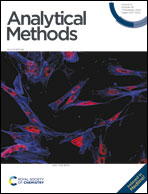Liquid chromatography mass spectrometry based characterization of epitope configurations†
Abstract
Here we evaluate a quick and easy tool for determination of epitope configuration using immunocapture and liquid chromatography mass spectrometry (LC-MS) subsequent to pre-treatment of the target protein to disrupt its three-dimensional structure. The approach can be a valuable screening tool to identify antibodies that can be used in peptide capture by anti-protein antibodies. The experimental set-up was established using seven monoclonal antibodies (mAbs) with known linear or conformational epitope recognition. The mAbs were developed to target either of the two biomarkers, progastrin releasing peptide (ProGRP) or human chorionic gonadotropin (hCG). Best coherence with established epitope configuration was seen when using both denaturation, reduction and alkylation as pre-treatment method of the proteins (≥70% reduction in MS signal intensity compared to control) prior to immunocapture and LC-MS determination. The final method was used to determine the epitope configuration of four anti-thyroglobulin mAbs with unknown epitope configuration; all four mAbs showed configurational epitope recognition. These results were also supported by western blots of native, and reduced and alkylated protein using three of the evaluated mAbs, and by analysis native, and reduced and alkylated protein in a routine immunofluorometric assay employing the four evaluated antibodies.



 Please wait while we load your content...
Please wait while we load your content...